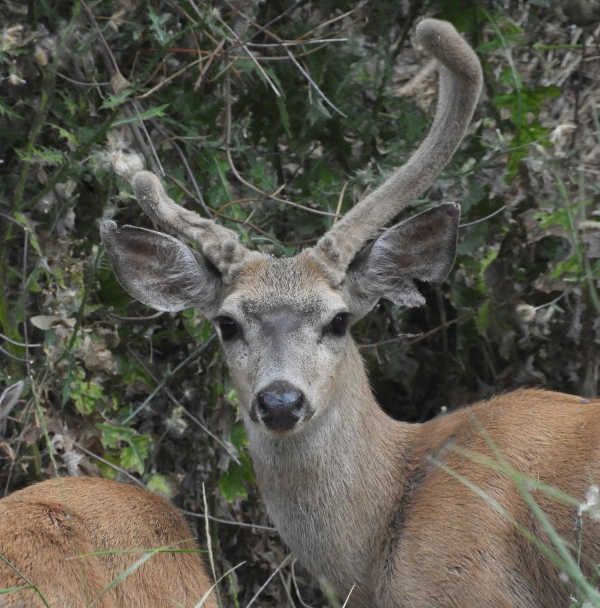
NORTHERN CALIFORNIA – Right now, you’re probably seeing a lot of our male regional Columbian Black-Tailed deer (Odocoileus hemionus columbianus) walking around in their “velvet,” that fuzzy material that covers their antlers while they grow.
Diet and disease both play a part in how robust the antlers are, but other factors can intervene and cause the antlers to come out wonky: stunted, mismatched or completely misshapen.
To understand how and why that might happen, you need to know a little bit about how the antlers develop.
Antlers grow from a specific connection point on the skull called a pedicle. What’s interesting about this antler-launch-point is that each deer’s pedicles have a pattern on them that is unique to that individual deer, like a fingerprint.
So, if you know what the pattern on the pedicle looks like, you can match it to the pattern on the base-end of the shed antlers later on in the year and know precisely which deer shed those antlers.
In black-tailed deer, hormonal changes in the summer months that herald the oncoming rut (breeding season) trigger the pedicles to start growing a new set of antlers.
At first, the antlers look fuzzy and have rounded tips. This is the “velvet” stage. The velvety-looking structures you see growing from the pedicles are actually antler material in its pre-calcified state and are made up of a concentrated network of cells, nerves blood vessels. During this stage, each antler can grow at the rate of a half-inch per day!
While they’re growing, the fuzz-covered antlers are extremely sensitive to touch and feel hot in your hand. Once the underlying structure of the antler calcifies, everything cools off and the outer layer of fuzz is shed revealing the sharp-tipped hard bone antler underneath it.
Although they’re made of bone, antlers aren’t permanent structures. In fact, black-tailed deer grow and shed their antlers every year, adding an extra tine (the pointy bit) to their rack every time the antlers are regrown. The first antler that sprouts has a single tine, and male deer sporting these lone tines are referred to as “spike bucks.”

It takes about two years, though, before the pedicle is strong enough to support the antlers, so the deer you see out there with antlers are actually older than the number of tines on their racks. Spike bucks can actually be up to 3 years old.
Trying to guess the age of any black-tailed deer by the tines on its antlers alone can be made even more difficult by the fact that intervening factors can cause the antlers to come out stunted or stubby, bent into odd contortions, or completely mismatched.
Distortions in the growth of the antlers can be caused, for example, if the pedicle on the skull is cracked or damaged, or the antler itself is broken while in the velvet stage. Whether or not the distortion caused by these injuries is permanent depends on when the damage occurs and how severe it was.
Let’s say an antler is broken during its velvet stage this year. The distortion that break caused will be visible in the hardened antler for the duration of this breeding season. But when the breeding season is over, and the antlers are shed and start to regrow next year, that distortion will no longer appear. If the pedicle, that anchor point from which the antlers grow, itself is damaged, however, distortions to the antlers can appear every year for the rest of the deer’s life.
Another factor that can affect antler growth comes in the form of what biologists call “systemic influence”, which loosely means that what happens to one part of an animal’s body can have a direct impact on an entirely different system in the same animal’s body.
In the case of black-tailed deer, this influence can be seen when antler deformations appear as a result of damage to the nerves in the deer’s hind legs. Usually, but not always, the deformed antler will appear on the side opposite of the leg that suffered the nerve damage. So, nerve damage in the right hind leg may show up, through systemic influence, as a deformed left antler.
See? There’s a lot more to antlers than you might have realized. Just for fun, get out there and check out the deer in your area. How many wonky antlers can you find?
Mary K. Hanson is a Certified California Naturalist, author and nature photographer, living with terminal cancer. She developed and helps to teach the naturalist program at Tuleyome, a 501(c)(3) nonprofit conservation organization based in Woodland. For more information, see their website at http://tuleyome.org/.


 How to resolve AdBlock issue?
How to resolve AdBlock issue? 





